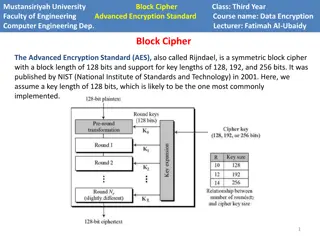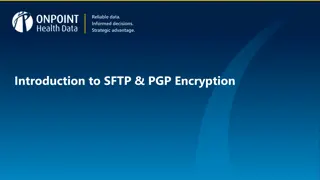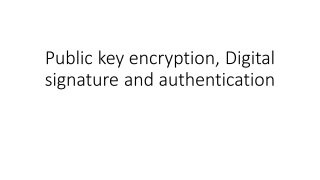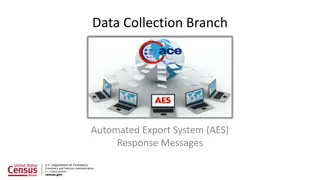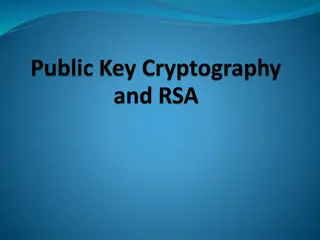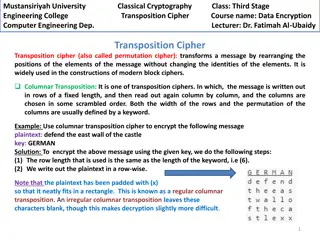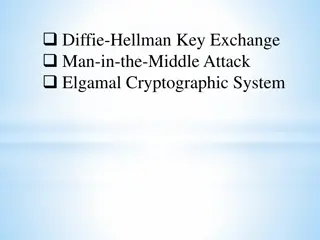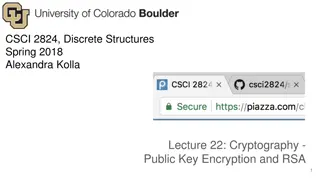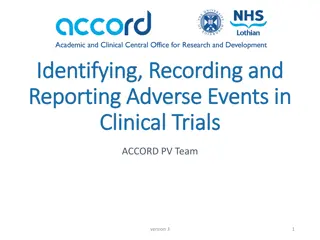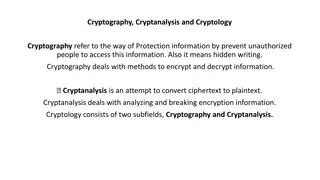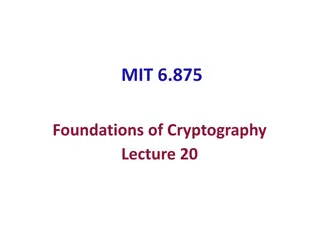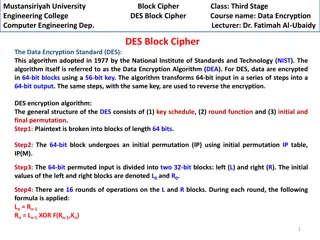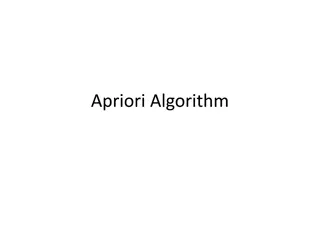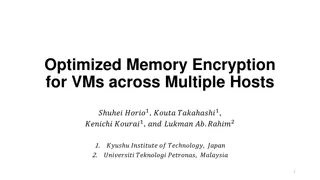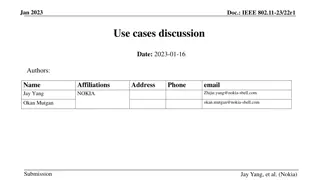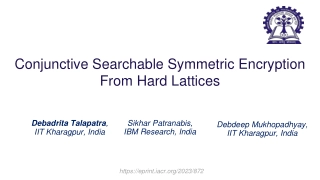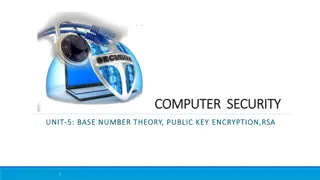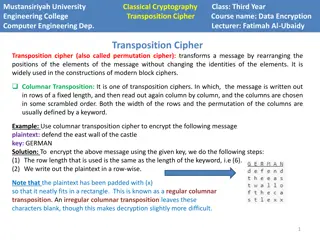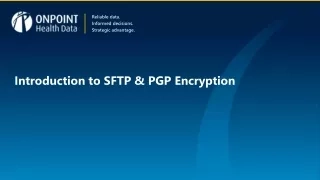Understanding AES Encryption Algorithm and Its Implementation
Learn about the Advanced Encryption Standard (AES) algorithm - a NSA-approved NIST standard encryption method. Explore how AES works, its key rounds, SubBytes, ShiftRows, MixColumns operations, and its optimization for embedded systems and small memory devices. Discover the importance of secure crypto practices and the risks of rolling your own encryption. Dive into the details of AES-128, AES-192, and AES-256 rounds and their encryption processes.
Download Presentation

Please find below an Image/Link to download the presentation.
The content on the website is provided AS IS for your information and personal use only. It may not be sold, licensed, or shared on other websites without obtaining consent from the author. Download presentation by click this link. If you encounter any issues during the download, it is possible that the publisher has removed the file from their server.
E N D
Presentation Transcript
Shield Icon Png #432401 - Free Icons Library AES AES in P4 P4 using scrambled lookup tables Xiaoqi Chen
Secure Apps Need Secure Crypto Never roll your own crypto ! CRC-32 is likely not secure enough Data plane: many computational constraints Short pipeline, simple arithmetic Is standardized crypto still possible? Maybe?
AES: An Intro NSA Approved NIST standard encryption algorithm Block cipher , encrypt data 16 bytes at a time Uses 10, 12, or 14 encryption rounds Each round: AddRoundKey SubBytes ShiftRows MixColumns
An AES Round 16-byte round key k0,0 k1,0 k2,0 k3,0 Substitution box (S-box) k0,1 k1,1 k2,1 k3,1 In 00 01 02 03 04 05 k0,2 k1,2 k2,2 k3,2 Out 63 7B 77 7B F2 6B k0,3 k1,3 k2,3 k3,3 a0,0 a1,0 a2,0 a3,0 b0,0 b1,0 b2,0 b3,0 c0,0 c1,0 c2,0 c3,0 (1) AddRoundKey: using XOR (2) SubBytes: lookup in S-box a0,1 a1,1 a2,1 a3,1 b0,1 01 b2,1 b3,1 c0,1 7B c2,1 c3,1 a0,2 a1,2 a2,2 a3,2 b0,2 b1,2 b2,2 b3,2 c0,2 c1,2 c2,2 c3,2 a0,3 a1,3 a2,3 a3,3 b0,3 b1,3 b2,3 04 c0,3 c1,3 c2,3 F2
An AES Round c0,0 c1,0 c2,0 c3,0 c0,1 c1,1 c2,1 c3,1 c0,2 c1,2 c2,2 c3,2 c0,3 c1,3 c2,3 c3,3
An AES Round (4) MixColumns: Polynomial Multiplication under GF(28), modulus (x4+1) a(x) = 3x3+x2+x+2 b(x) = c1,0x3+c2,1x2+c3,2x+c0,3 d(x) = a(x) b(x) mod (x4+1) (3) ShiftRows: each row cyclically shifted by 0, 1, 2, or 3 positions = d1,0x3+d1,1x2+d1,2x+d1,3 c0,0 c1,0 c2,0 c3,0 c0,0 c1,0 c2,0 c3,0 d0,0 d1,0 d2,0 d3,0 c0,1 c1,1 c2,1 c3,1 c1,1 c2,1 c3,1 c0,1 d0,1 d1,1 d2,1 d3,1 c0,2 c1,2 c2,2 c3,2 c2,2 c3,2 c0,2 c1,2 d0,2 d1,2 d2,2 d3,2 c0,3 c1,3 c2,3 c3,3 c3,3 c0,3 c1,3 c2,3 d0,3 d1,3 d2,3 d3,3
An AES Round Rinse and repeat! AES-128: 10 rounds AES-192: 12 rounds AES-256: 14 rounds a0,0 a1,0 a2,0 a3,0 d0,0 d1,0 d2,0 d3,0 a0,1 a1,1 a2,1 a3,1 d0,1 d1,1 d2,1 d3,1 a0,2 a1,2 a2,2 a3,2 d0,2 d1,2 d2,2 d3,2 a0,3 a1,3 a2,3 a3,3 d0,3 d1,3 d2,3 d3,3
Different Optimization Objectives Embedded system P4 switch Very small memory Relatively larger memory Don t use large lookup tables For routing tables Sequential computation Parallel data flow Run many cycles Challenge: limited # stages
Solution: Scrambled Lookup Table 12 k1,0 k2,0 k3,0 Pre-computed Scrambled Lookup Tables 34 k1,1 k2,1 k3,1 In 00 01 02 03 04 05 In 00 01 02 03 04 05 In 00 01 02 03 04 05 71 k1,2 k2,2 k3,2 In XOR k0,0 In XOR k1,0 In XOR k0,2 12 13 10 11 16 17 34 35 36 37 30 31 55 k1,3 k2,3 k3,3 71 70 73 72 75 74 Out Out Out 63 7B 77 7B F2 6B 63 7B 77 7B F2 6B 63 7B 77 7B F2 6B a0,0 a1,0 a2,0 a3,0 c0,0 c1,0 c2,0 c3,0 16 tables per round, one for each ki,j a0,1 a1,1 a2,1 a3,1 c0,1 c1,1 c2,1 c3,1 75 a1,2 a2,2 a3,2 F2 c1,2 c2,2 c3,2 a0,3 a1,3 a2,3 a3,3 c0,3 c1,3 c2,3 c3,3
Solution: Scrambled Lookup Table Use 160x~224x memory space to save XORs Input block -> Lookup -> XOR -> Output block Theoretical minimum: 2 stage per round Each table costs 1KB Justifiable in switches: short pipeline, MBs of memory
Evaluation Does it actually fit? Theoretically SLTs costs 160~224 KB of memory in total In practice, occupied <15% of SRAM on Tofino v1 Other resource utilization are negligible So, what is the real-world performance? 10Gbit/s @ two rounds per pass (200Gbps recirculation limit) 122% improvement compared with baseline (one round per pass)
Evaluation Macbook Pro 15" - =1.3x =0.3x Tofino Wedge100-32x, $8000 MacBook Air 13 2017, $1200 Intel i7 (AES-NI), 2.2Ghz 2 cores MacBook Pro 16 2019, $2400 Intel i7 (AES-NI), 2.6Ghz 6 cores Macbook Pro 15" - =11x =2.4x Use 50% ports for recirculation
Conclusion & Future Directions AES runs on P4 switches! Please, avoid hand-rolled crypto Scrambled Lookup Table: save XORs using 160~224KB memory Two rounds per pass, improves throughput by 122% Tofino v1 is not the best device to run AES Other algorithms? Is Feistel Cipher more PISA-friendly? Fewer rounds? Dedicated crypto co-processor in switches? Our P4 code is open-source! github.com/Princeton-Cabernet/p4-projects

